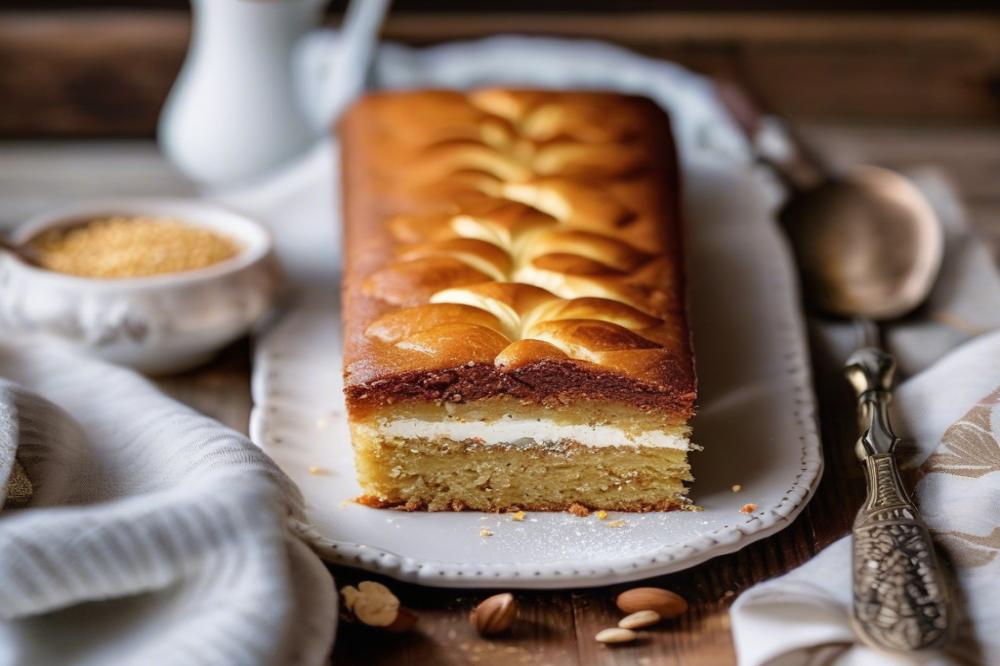Understanding Fanouropita
Fanouropita is a delightful Greek cake closely tied to the celebration of Saint Fanourios. This traditional dessert boasts rich flavors and a warm aroma, making it a favorite among many during religious festivities. Each bite reveals a blend of simple ingredients like olive oil and cinnamon, creating a sweet bread that comforts the spirit.
In Greek culture, this cake holds special significance. It is often baked to ask for blessings or to commemorate the memory of loved ones. Families gather to share this special treat, reinforcing the bonds that unite them. The act of baking itself becomes a ritual filled with meaning and devotion.
The article will explore the steps it takes to create this beloved dessert. Readers will learn about the ingredients and the methods involved in crafting a genuine Fanouropita. Tips for incorporating nuts and rosemary into the recipe will also be shared, enhancing the cake’s flavors further. Finally, we’ll provide insights into serving and enjoying this timeless Greek culinary treasure.
What is Fanouropita

Fanouropita is a delightful Greek cake traditionally baked for the feast of Saint Fanourios. This dessert features a rich blend of flavors, combining elements like cinnamon, nuts, and olive oil. Its origins can be traced back to various regions within Greece, where families have passed down the recipe through generations.
The connection to the feast of Saint Fanourios is significant. Legend says that he helps people find lost items. Therefore, many bake this sweet bread to honor him and to seek his assistance in finding what they’ve mislaid. Each bite offers a taste of this spiritual communion, bridging the earthly with the divine.
As families gather to celebrate, baking this cake often becomes a cherished ritual. Some will add rosemary to enhance its aroma, while others prefer a more nutty texture. Each household possesses its own traditional recipe, which varies slightly from one family to another. Sharing the cake afterward becomes a moment of togetherness as loved ones enjoy the warm, inviting flavors. It offers not just a sweet treat, but also a connection to their heritage and beliefs. Fans of Greek cuisine appreciate how fanouropita symbolizes love, hope, and remembrance during gatherings.
Ingredients List and Nutritional Information

Baking a delicious Greek Saint Fanourios cake, known as Fanouropita, requires some precise ingredients. Gather the following items to get started:
- Flour: 3 cups
- Sugar: 1 cup
- Olive oil: 1 cup
- Water: 1 cup
- Baking powder: 1 tablespoon
- Cinnamon: 1 teaspoon
- Chopped nuts (walnuts or almonds): 1 cup
- Raisins: 1 cup
- Fresh rosemary: 1 tablespoon
Now let’s take a look at the nutritional information for each ingredient. Flour provides carbohydrates, which are essential for energy. Sugar adds sweetness but should be consumed in moderation due to its high caloric content. Olive oil is a heart-healthy fat, known for its rich flavor and various health benefits. Water is crucial for hydration and balances the other components. Baking powder acts as a leavening agent, making the cake rise nicely.
Cinnamon not only offers a warm spice flavor but also contains antioxidants. It may help to regulate blood sugar levels. Nuts, whether you choose walnuts or almonds, are packed with protein and healthy fats, making the cake more nutritious. Raisins add natural sweetness and are a good source of fiber. Fresh rosemary brings a unique flavor twist that pairs well with the other ingredients.
Using olive oil in baking not only enhances flavor but also provides heart-healthy monounsaturated fats. This oil is rich in antioxidants, which can support a healthy lifestyle. Nuts contribute various vitamins and minerals, improving the overall nutrition of your dessert. Their healthy fats can promote good heart health and keep you fuller longer.
Cooking Instructions

Step-by-step instructions for preparing Fanouropita
Start by gathering all your ingredients. You will need flour, sugar, baking powder, cinnamon, and a touch of salt. Additionally, mix in some chopped nuts for a delightful crunch. You’re also going to need olive oil, orange juice, and rosemary. This combination is what makes this Greek cake truly special. In a large bowl, combine the dry ingredients first. Stir together the flour, sugar, baking powder, cinnamon, and salt. Use a whisk to break up any lumps.
Next, in another bowl, mix the olive oil, orange juice, and finely chopped rosemary. Pour this mixture into the dry ingredients and stir gently. It is important not to overmix. The key is to combine until just incorporated. If using nuts, fold them in at this stage. They add both texture and flavor to your dessert.
Instructions for baking time and temperature
Prepare your oven by preheating it to 350°F (175°C). While the oven warms up, grab a baking pan. It should be greased and lined with parchment paper for easier removal. Pour the batter into the prepared pan. Spread it evenly. Bake for about 35 to 40 minutes. The cake should rise beautifully and turn a lovely golden brown color.
Tips for checking doneness and achieving the right texture
To check if it’s done, gently insert a toothpick into the center. If it comes out clean or with a few crumbs, your cake is ready. Take care to not overbake. This could result in a dry dessert. The right texture should be moist yet firm.
Let the cake cool in the pan for about 10 minutes before flipping it onto a wire rack. This will help maintain the structure and enhance the overall presentation. Don’t forget that Fanouropita is often best enjoyed at room temperature. The mingling of flavors, especially from the cinnamon and rosemary, truly shines when allowed to rest. Enjoy the process of making this traditional recipe; it’s a wonderful representation of Greek cuisine!
Serving Suggestions and Variations

Traditional Ways to Serve Fanouropita
Serving this delightful Greek cake can be quite simple. Traditionally, it is cut into squares and served at room temperature. Many choose to offer it with a cup of Greek coffee or herbal tea. The rich flavors pair well with both beverages. Friends and family often come together to enjoy this dessert, especially during religious celebrations. Sharing it at gatherings enhances its significance, connecting people with their traditions.
Garnishing Ideas
Garnishing options add a special touch to the presentation. A dusting of powdered sugar creates a lovely contrast against the golden crust. Additionally, chopped nuts provide an unexpected crunch. Almonds or walnuts are popular choices for this sweet bread. You might also sprinkle cinnamon on top, adding a comforting aroma and warmth. For a unique twist, try adding a sprig of rosemary. This herb gives a hint of earthiness, which many find delightful.
Variations Across Regions of Greece
Different regions of Greece have their own takes on this dessert. In some areas, locals might incorporate orange zest or juice, which adds brightness to the cake. Others may choose to use anise or cloves for a spicier flavor. Certain families bake it with chunks of apple or pear mixed into the batter, creating a moist texture. Olives also find their way into some recipes, showcasing the versatility of Greek cuisine. Each variation tells a story about local ingredients and traditions. Not one recipe is exactly the same, making it a special treat no matter where you find it.
Cultural Significance of Fanouropita
The Greek cake known as Fanouropita carries deep cultural and religious meaning. Traditionally, this dessert is associated with the Feast of Saint Fanourios, celebrated on August 27. People often bake this sweet bread in honor of the saint, seeking his blessings and guidance. The act of baking becomes a religious ritual. Many believe that sharing slices of this cake can help find lost items or wish for something important.
Special gatherings often take place during the celebration days. Friends and family come together to enjoy this delightful treat, sharing personal stories of faith and hope. The cake is typically made with simple ingredients like olive oil, flour, and spices. Common flavors include cinnamon and a hint of rosemary, giving it an aromatic touch. Chopped nuts may also be added, adding texture and flavor.
Each family often has its traditional recipe passed down through generations. Variations can be seen among different regions in Greece too. While one household might bake a lighter version, another might prefer it rich and moist. Regardless of how it is made, the act of baking this cake helps strengthen community bonds during celebrations.
As people gather to enjoy the cake, they often share personal anecdotes. Stories of lost dreams being found or prayers being answered often accompany each slice of this delightful dessert. For many, the act of sharing Fanouropita serves as a reminder of beloved traditions. It helps to connect them with their ancestry and cultural roots.
Embracing Tradition with Every Slice
Fanouropita is a cherished Greek dessert that blends history and flavor in every bite. The warmth of its cinnamon and the sweetness of the sugar evoke the essence of home and tradition, making it not just a tasty treat but a symbol of love and remembrance. Traditionally prepared for the feast of Saint Fanourios, this Greek cake is more than just food; it carries deep-rooted cultural significance. Each slice serves as a reminder of the need to honor our ancestors and preserve our customs.
Baking this delightful dish at home can be a rewarding experience. The process offers an opportunity to connect with heritage. Gather your ingredients, follow the simple steps, and immerse yourself in the rich aromas wafting through your kitchen. Enjoying a piece of freshly baked cake with family or friends creates memorable moments filled with laughter and joy.
Preserving traditional recipes like this one is crucial for passing down generations of history and culture. It allows us to keep alive the stories and traditions that have shaped our identities. As you bake, think of the hands that prepared it before you and the joy it brought to countless homes. Encourage others to explore these time-honored recipes; they hold valuable lessons about the past.
In closing, take this chance to bake, taste, and share. Not only will you enjoy a wonderful dessert, but you will also play a part in keeping Greek culinary traditions alive.



